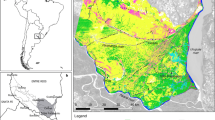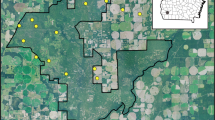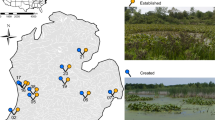Abstract
We evaluated changes in wetland abundance, size, and classification between average (1979–1986) and above-average (1995–1999) precipitation periods for two physiographic regions in eastern South Dakota. Temporal shifts in wetland numbers, area, and class varied by topographic location. In high wetland density areas (> 8 wetlands/100 ha), our data suggests that larger, semipermanent wetlands expanded and absorbed nearby wetland basins into their margins, resulting in a net “loss” or disappearance of temporary and seasonal wetlands in above-average water condition years. “Losses” described here are not deemed permanent as in cases of draining or filling, and wetlands may re-form when water conditions return to normal. Nevertheless, temporary disappearance of smaller more isolated wetlands may have implications for breeding waterfowl and other fauna. Percent change of semipermanent basin numbers was positively correlated with wetland density, whereas the opposite was true for seasonal wetlands. Loss of temporary wetlands was correlated with wetland aggregation within the sample area. However, in low wetland density areas, the number and size of seasonal and temporary wetlands generally increased following above-average precipitation. We suggest that wetlands’ spatial arrangement be considered along with traditional wetland quantification techniques to better account for shifts in wetland habitat in dry versus wet years.
Similar content being viewed by others
Literature Cited
Batt, D. J., M. G. Anderson, C. D. Anderson, and F. D. Caswell. 1989. Use of prairie potholes by North American ducks. p. 204–27. In A. G. van der Valk (ed.) Northern Prairie Wetlands. Iowa State University Press, Ames, IA, USA.
Bellrose, F. C. 1980. Ducks, Geese, and Swans of North America, third edition. Stackpole Books, Harrisburg, PA, USA.
Bluemle, J. P. 1991. Face of North Dakota. North Dakota Geological Survey. Educational Series 21. Bismark, ND, USA.
Cowardin, L. M., V. Carter, F. C. Golet, and E. T. LeRoe. 1979. Classification of Wetlands and Deepwater Habitats of the United States. U. S. Fish and Wildlife Service. FWS/OBS-79/31.
Cowardin, L. M., D. S. Gilmer, and L. M. Mechlin. 1981. Characteristics of North Dakota wetlands determined from sample aerial photographs and ground study. Wildlife Society Bulletin 9: 280–88.
Dahl, T. E. 2000. Status and trends of wetlands in the conterminous United States 1986–1997. U.S. Department of the Interior, Fish and Wildlife Service, Washington DC, USA.
Euliss, N. H., Jr., J. W. LaBaugh, L. H. Fredrickson, D. M. Mushet, M. K. Laubhan, G. A. Swanson, T. C. Winter, D. O. Rosenberry, and R. D. Nelson. 2004. The wetland continuum: a conceptual framework for interpreting biological studies. Wetlands 24: 448–58.
Euliss, N. H., Jr. and D. M. Mushet. 1996. Water-level fluctuation in wetlands as a function of landscape condition in the prairie pothole region. Wetlands 16: 587–93.
Euliss, N. H., Jr., D. M. Mushet, and D. A. Wrubleski. 1999. Wetlands of the prairie pothole region: invertebrate species composition, ecology, and management. p. 471–514. In D. P. Batzer, R. B. Rader, and S. A. Wissinger (eds.) Invertebrates in freshwater wetlands of North America: Ecology and management. John Wiley & Sons, New York, NY, USA.
Flint, R. F. 1971. Glacial and Quaternary Geology. John Wiley & Sons, New York, NY, USA.
Gleason, R. A., N. H. Euliss, D. E. Hubbard, and W. G. Duffy. 2003. Effects of sediment load on emergence of aquatic invertebrates and plants from soil egg and seed banks. Wetlands 23: 26–34.
Johnson, R. R. 1995. Demographics of eastern South Dakota wetland basins and techniques for estimating the area and number of wetland basins. Ph.D. Dissertation. South Dakota State University, Brookings, SD, USA.
Johnson, R. R. and K. F. Higgins. 1997. Wetland Resources of Eastern South Dakota. South Dakota State University, Brookings, SD, USA.
Johnson, W. C., S. E. Boettcher, K. A. Poiani, and G. Guntenspergen. 2004. Influence of weather extremes on the water levels of the glaciated prairie wetlands. Wetlands 24: 385–98.
Johnson, W. C., B. V. Millet, T. Gilmanov, R. A. Voldseth, G. R. Guntenspergen, and D. E. Naugle. 2005. Vulnerability of northern prairie wetlands to climate change. Bioscience 55: 863–72.
Kantrud, H. A. and R. E. Stewart. 1977. Use of natural basin wetlands by breeding waterfowl in North Dakota. Journal of Wildlife Management 41: 243–53.
Karl, T. R. and W. E. Riebsame. 1984. The identification of 10 to 20 year temperature and precipitation fluctuations in the contiguous United States. Journal of Climate and Applied Meteorology 23: 950–66.
Krapu, G. L., R. J. Greenwood, C. P. Dwyer, K. M. Kraft, and L. M. Cowardin. 1997. Wetland use, settling patterns and recruitment in mallards. Journal of Wildlife Management 61: 736–46.
Luoma, J. R. 1985. Twilight in pothole country. Audubon 87: 68–84.
McGarigal, K. and B. J. Marks. 1995. FRAGSTATS: spatial pattern analysis program for quantifying landscape structure. U.S. Department of Agriculture, Forest Service, Pacific Northwest Research Station. General Technical Report. Portland, OR, USA. PNW-GTR-351
Mitsch, W. J. and J. G. Gosselink. 1993. Wetlands, second edition. Van Nostrand & Reinhold, New York, NY, USA.
Murkin, H. R. and P. J. Caldwell. 2000. Avian use of prairie wetlands. p. 249–86. In H. R. Murkin, H. R., A. G. van der Valk, and W. R. Clark (eds.) Prairie Wetland Ecology: The contribution of the marsh ecology research program. Iowa State University Press, Ames, IA, USA.
Rieger, B. 2004. Demographics of western South Dakota wetlands and basins. Masters Thesis, South Dakota State University, Brookings, SD, USA.
Reynolds, R. E., T. L. Shaffer, C. R. Loesch, and R. R. CoxJr. 2006. The Farm Bill and duck production in the prairie pothole region: increasing the benefits. Wildlife Society Bulletin 34: 963–74.
SAS Institute, Incorporated. 2003. The SAS system for Windows. SAS Institute, Cary, NC, USA.
Shapley, M. D., W. C. Johnson, E. R. Engstrom, and W. R. Osterkamp. 2005. A 1000-year record of late-Holocene flooding and drought in Day County, South Dakota, reconstructed from tree rings, lake sediments and ancient shorelines. The Holocene 15: 29–41.
StatSoft Incorporated. 2003. STATISTICA (data analysis software system). Tulsa, OK, USA.
Sorensen, L. G., R. Goldberg, T. L. Root, and M. G. Anderson. 1998. Potential effects of global warming on waterfowl populations breeding in the northern Great Plains. Climate Change 40: 343–69.
Swanson, G. A., M. I. Meyer, and V. A. Adomaitis. 1985. Foods consumed by breeding mallards on wetlands of south-central North Dakota. Journal of Wildlife Management 49: 197–203.
Talent, L. G., G. Krapu, and R. L. Jarvis. 1982. Habitat use by mallard broods in south-Central North Dakota. Journal of Wildlife Management 46: 629–35.
Tiner, R. W. 2003. Geographically isolated wetlands of the United States. Wetlands 3: 494–516.
U.S. Fish and Wildlife Service. 2007. Waterfowl population status, 2007. U. S. Department of the Interior, Washington, D. C., U.S.A.
van der Valk, A. G., H. R. Murkin, and J. A. Kadlec. 2000. The drawdown and reflooding years. p. 75–98. In H. R. Murkin, A. G. van der Valk, and W. R. Clark (eds.) Prairie Wetland Ecology: the contribution of the marsh ecology research program. 2000. Iowa State University Press, IA, USA.
Weller, M. W. 1981. Freshwater Marshes. Ecology and Wildlife Management. University of Minnesota, MN, USA.
Weller, M. W. and C. E. Spatcher. 1965. Role of habitat in the distribution and abundance of marsh birds. Iowa Agricultural and Home Economics Experimental Station, Special Report 43, Ames, IA, USA.
Winter, T. C. and D. O. Rosenberry. 1998. Hydrology of prairie pothole wetlands during drought and deluge: a 17 year study of the cottonwood lake wetland complex in North Dakota in the perspective of longer term measured and proxy hydrological records. Climatic Change 40: 189–209.
Woodhouse, C. A. and J. T. Overpeck. 1998. 2000 years of drought variability in the central United States. Bulletin of the American Meteorological Society 79: 2693–2714.
Author information
Authors and Affiliations
Corresponding author
Rights and permissions
About this article
Cite this article
Kahara, S.N., Mockler, R.M., Higgins, K.F. et al. Spatiotemporal patterns of wetland occurrence in the Prairie Pothole Region of eastern South Dakota. Wetlands 29, 678–689 (2009). https://doi.org/10.1672/07-09.1
Received:
Accepted:
Issue Date:
DOI: https://doi.org/10.1672/07-09.1




